直播弹幕系统(二)- 整合RabbitMQ进行消息广播和异步处理
前言
上一篇文章 SpringCloud网关对WebSocket链接进行负载均衡 中把主要的架子搭建好了,这一篇文章就要开始写业务逻辑了。在分布式系统下,如何达到SpringBoot - WebSocket的使用和聊天室练习的效果。
一. Socket服务整合RabbitMQ
我们页面上,通过
WebSocket
发送弹幕信息的时候,后端通过
@OnMessage
注解修饰的函数进行接收。这里我们统一将原始的弹幕消息丢给
MQ
。让另一个专业的弹幕服务去消费处理。目的也是希望
WebSocket
服务它只负责消息的传递和
WebSocket
信息的维护,业务逻辑啥也不做。
1.添加
pom
依赖:
<dependency><groupId>org.springframework.boot</groupId><artifactId>spring-boot-starter-amqp</artifactId></dependency>
2.配置文件
bootstrap.yml
,添加RabbitMQ相关配置
server:port:81spring:application:name: tv-service-socket
cloud:nacos:discovery:server-addr: 你的Nacos地址:8848rabbitmq:username: guest
password: guest
# 虚拟主机,默认是/virtual-host: /
# 超时时间connection-timeout:30000listener:simple:# 消费模式,手动acknowledge-mode: manual
# 并发数concurrency:5# 最大并发数max-concurrency:10# 限流,如果严格控制消费顺序,这里应该填1,数值越大,消费处理速度越快。MQ会把这个数值的消息放到缓存当中。# 因此数值越大,内存占用越大,还需要考虑消费的速度prefetch:10addresses: 你的RabbitMQ地址:5672
配置类:RabbitMQ
importorg.springframework.amqp.core.Binding;importorg.springframework.amqp.core.BindingBuilder;importorg.springframework.amqp.core.DirectExchange;importorg.springframework.amqp.core.Queue;importorg.springframework.context.annotation.Bean;importorg.springframework.context.annotation.Configuration;/**
* @author Zong0915
* @date 2022/12/15 下午1:29
*/@ConfigurationpublicclassRabbitMQConfig{@BeanpublicQueueinitDirectQueue(){returnnewQueue("originBullet-queue",true);}@BeanDirectExchangeinitDirectExchange(){returnnewDirectExchange("bulletPreProcessor-exchange",true,false);}@BeanBindinginitBindingDirect(){returnBindingBuilder.bind(TestDirectQueue()).to(TestDirectExchange()).with("bullet.originMessage");}}
4.写一个简单的消息体
OriginMessage
,发送到
MQ
的:
importlombok.Data;/**
* @author Zong0915
* @date 2022/12/15 下午1:30
*/@DatapublicclassOriginMessage{privateString sessionId;privateString userId;privateString roomId;privateString message;}
生产者MQ
:OriginMessageSender
/**
* @author Zong0915
* @date 2022/12/15 下午1:29
*/@ComponentpublicclassOriginMessageSender{@AutowiredprivateRabbitTemplate rabbitTemplate;publicvoidsend(OriginMessage originMessage){CorrelationData correlationData =newCorrelationData();
correlationData.setId(UUID.randomUUID().toString());// 唯一IDMap<String,Object> map =newHashMap<>();
map.put("message",JSONObject.toJSONString(originMessage));// 发送给消息预处理队列
rabbitTemplate.convertAndSend("bulletPreProcessor-exchange",// 交换机名称"bullet.originMessage",// 路由Key
map, correlationData);}}
6.我们再对
WebSocket
的监听类做一下小改动,将收到的消息,封装一下,然后调用生产者的
API
即可。只需要注意一下多例下属性的注入方式是怎么写的即可。
importkz.cache.SocketCache;importkz.entity.OriginMessage;importkz.producer.OriginMessageSender;importlombok.extern.slf4j.Slf4j;importorg.apache.commons.lang3.StringUtils;importorg.springframework.beans.factory.annotation.Autowired;importorg.springframework.stereotype.Component;importjavax.websocket.OnClose;importjavax.websocket.OnMessage;importjavax.websocket.OnOpen;importjavax.websocket.Session;importjavax.websocket.server.PathParam;importjavax.websocket.server.ServerEndpoint;importjava.util.concurrent.atomic.AtomicLong;importlombok.Getter;/**
* @author Zong0915
* @date 2022/12/9 下午3:45
*/@Component@ServerEndpoint("/websocket/live/{roomId}/{userId}")@Slf4j@GetterpublicclassBulletScreenServer{/**
* 多例模式下的赋值方式
*/privatestaticOriginMessageSender originMessageSender;/**
* 多例模式下的赋值方式
*/@AutowiredprivatevoidsetOriginMessageSender(OriginMessageSender originMessageSender){BulletScreenServer.originMessageSender = originMessageSender;}privatestaticfinalAtomicLong count =newAtomicLong(0);privateSession session;privateString sessionId;privateString userId;privateString roomId;/**
* 打开连接
* @param session
* @OnOpen 连接成功后会自动调用该方法
*/@OnOpenpublicvoidopenConnection(Session session,@PathParam("roomId")String roomId,@PathParam("userId")String userId){// 如果是游客观看视频,虽然有弹幕,但是没有用户信息,所以需要用try
count.incrementAndGet();
log.info("*************WebSocket连接次数: {} *************", count.longValue());this.userId = userId;this.roomId = roomId;// 保存session相关信息到本地this.sessionId = session.getId();this.session = session;SocketCache.put(sessionId,this);}/**
* 客户端刷新页面,或者关闭页面,服务端断开连接等等操作,都需要关闭连接
*/@OnClosepublicvoidcloseConnection(){SocketCache.remove(sessionId);}/**
* 客户端发送消息给服务端
* @param message
*/@OnMessagepublicvoidonMessage(String message){if(StringUtils.isBlank(message)){return;}// 将消息丢给MQ,业务上的处理什么也不管,交给弹幕业务来处理,并且达到削峰的目的
originMessageSender.send(buildMessage(message));}privateOriginMessagebuildMessage(String message){OriginMessage originMessage =newOriginMessage();
originMessage.setMessage(message);
originMessage.setRoomId(roomId);
originMessage.setSessionId(sessionId);
originMessage.setUserId(userId);return originMessage;}}
备注:记得将另一个
Socket
项目也改造成同样的代码。
二. 弹幕服务创建
2.1 创建一个公共maven项目
我们创建一个
maven
项目:
service-bulletcommon
。先看下最终的项目架构: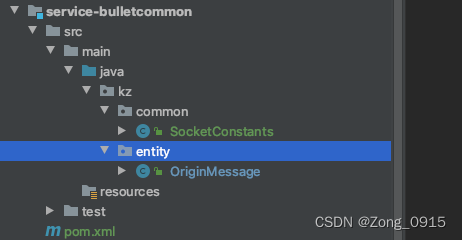
依赖添加一些常用的工具:pom
<groupId>bullet-service</groupId><artifactId>service-bulletcommon</artifactId><version>1.0-SNAPSHOT</version><dependencies><dependency><groupId>org.apache.commons</groupId><artifactId>commons-lang3</artifactId><version>3.12.0</version></dependency><dependency><groupId>com.alibaba</groupId><artifactId>fastjson</artifactId><version>1.2.79</version></dependency><dependency><groupId>org.projectlombok</groupId><artifactId>lombok</artifactId><version>1.18.24</version></dependency><dependency><groupId>commons-collections</groupId><artifactId>commons-collections</artifactId><version>3.2.2</version></dependency></dependencies>
2.创建一个常量定义类
SocketConstants
:
/**
* @author Zong0915
* @date 2022/12/15 下午3:59
*/publicclassSocketConstants{/**
* 这条消息是否处理过
*/publicstaticfinalStringCORRELATION_SET_PRE="Correlation_Set_";/**
* 同一个房间里面有哪些SessionID
*/publicstaticfinalStringROOM_LIVE_USER_SET_PRE="ROOM_LIVE_USER_Set_";publicstaticfinalStringMESSAGE="message";publicstaticfinalStringID="id";/**
* 原始消息所在队列
*/publicstaticfinalStringORIGIN_BULLET_QUEUE="originBullet-queue";/**
* 广播队列A
*/publicstaticfinalStringBULLET_SOCKET_QUEUE_A="bulletSocket-queueA";/**
* 广播队列B
*/publicstaticfinalStringBULLET_SOCKET_QUEUE_B="bulletSocket-queueB";/**
* 弹幕预处理交换机
*/publicstaticfinalStringBULLET_PRE_PROCESSOR_EXCHANGE="bulletPreProcessor-exchange";/**
* 弹幕广播交换机
*/publicstaticfinalStringBULLET_FANOUT_EXCHANGE="bulletFanOut-exchange";/**
* 弹幕预处理路由Key
*/publicstaticfinalStringBULLET_ORIGIN_MESSAGE_ROUTE_KEY="bullet.originMessage";}
3.创建一个消息传输体
OriginMessage
:
importlombok.Data;/**
* @author Zong0915
* @date 2022/12/15 下午2:07
*/@DatapublicclassOriginMessage{privateString sessionId;privateString userId;privateString roomId;privateString message;}
2.2 弹幕服务项目创建
1.我们创建一个
maven
项目:
service-bulletscreen
。先看下最终的项目架构:
文件:pom
<parent><groupId>org.springframework.boot</groupId><artifactId>spring-boot-starter-parent</artifactId><version>2.3.2.RELEASE</version><relativePath/><!-- lookup parent from repository --></parent><dependencies><dependency><groupId>org.springframework.boot</groupId><artifactId>spring-boot-starter-web</artifactId></dependency><dependency><groupId>com.alibaba.cloud</groupId><artifactId>spring-cloud-starter-alibaba-nacos-discovery</artifactId><version>2.2.1.RELEASE</version><exclusions><exclusion><artifactId>archaius-core</artifactId><groupId>com.netflix.archaius</groupId></exclusion><exclusion><artifactId>commons-io</artifactId><groupId>commons-io</groupId></exclusion><exclusion><artifactId>commons-lang3</artifactId><groupId>org.apache.commons</groupId></exclusion><exclusion><artifactId>fastjson</artifactId><groupId>com.alibaba</groupId></exclusion><exclusion><artifactId>guava</artifactId><groupId>com.google.guava</groupId></exclusion><exclusion><artifactId>httpclient</artifactId><groupId>org.apache.httpcomponents</groupId></exclusion><exclusion><artifactId>servo-core</artifactId><groupId>com.netflix.servo</groupId></exclusion></exclusions></dependency><dependency><groupId>org.springframework.boot</groupId><artifactId>spring-boot-starter-amqp</artifactId></dependency><dependency><groupId>org.springframework.boot</groupId><artifactId>spring-boot-starter-data-redis</artifactId><version>2.6.7</version><exclusions><exclusion><artifactId>log4j-api</artifactId><groupId>org.apache.logging.log4j</groupId></exclusion></exclusions></dependency><dependency><groupId>bullet-service</groupId><artifactId>service-bulletcommon</artifactId><version>1.0-SNAPSHOT</version></dependency></dependencies>
:application.properties
spring.application.name=tv-service-bulletscreen
spring.cloud.nacos.discovery.server-addr=你的Nacos地址:8848
文件:bootstrap.yml
server:
port:83
spring:
application:
name: tv-service-bulletscreen
redis:
database:0 # Redis数据库索引(默认为0)
host: 你的Redis地址 # Redis的服务地址
port:6379 # Redis的服务端口
password: 密码
jedis:
pool:
max-active:8 # 连接池最大连接数(使用负值表示没有限制)
max-wait:-1 # 连接池最大阻塞等待时间(使用负值表示没有限制)
max-idle:8 # 连接池中的最大空闲连接
min-idle:0 # 连接池中的最小空闲链接
timeout:30000 # 连接池的超时时间(毫秒)
cloud:
nacos:
discovery:
server-addr: 你的Nacos地址:8848
rabbitmq:
username: guest
password: guest
# 虚拟主机,默认是/
virtual-host:/
# 超时时间
connection-timeout:30000
listener:
simple:
# 消费模式,手动
acknowledge-mode: manual
# 并发数
concurrency:5
# 最大并发数
max-concurrency:10
# 限流,如果严格控制消费顺序,这里应该填1,数值越大,消费处理速度越快。MQ会把这个数值的消息放到缓存当中。
# 因此数值越大,内存占用越大,还需要考虑消费的速度
prefetch:10
addresses: 你的RabbitMQ地址:5672
配置类Redis
:RedisConfig
importorg.springframework.boot.autoconfigure.condition.ConditionalOnMissingBean;importorg.springframework.context.annotation.Bean;importorg.springframework.context.annotation.Configuration;importorg.springframework.data.redis.connection.RedisConnectionFactory;importorg.springframework.data.redis.core.RedisTemplate;importorg.springframework.data.redis.core.StringRedisTemplate;importorg.springframework.data.redis.serializer.GenericJackson2JsonRedisSerializer;importorg.springframework.data.redis.serializer.StringRedisSerializer;@ConfigurationpublicclassRedisConfig{/**
* 实例化 RedisTemplate 对象
*
* @return
*/@BeanpublicRedisTemplate<String,Object>functionDomainRedisTemplate(RedisConnectionFactory redisConnectionFactory){RedisTemplate<String,Object> redisTemplate =newRedisTemplate<>();initDomainRedisTemplate(redisTemplate, redisConnectionFactory);return redisTemplate;}/**
* 设置数据存入 redis 的序列化方式,并开启事务
*
* @param redisTemplate
* @param factory
*/privatevoidinitDomainRedisTemplate(RedisTemplate<String,Object> redisTemplate,RedisConnectionFactory factory){//如果不配置Serializer,那么存储的时候缺省使用String,如果用User类型存储,那么会提示错误User can't cast to String!
redisTemplate.setKeySerializer(newStringRedisSerializer());
redisTemplate.setHashKeySerializer(newStringRedisSerializer());
redisTemplate.setHashValueSerializer(newGenericJackson2JsonRedisSerializer());
redisTemplate.setValueSerializer(newGenericJackson2JsonRedisSerializer());// 开启事务
redisTemplate.setEnableTransactionSupport(true);
redisTemplate.setConnectionFactory(factory);}@Bean@ConditionalOnMissingBean(StringRedisTemplate.class)publicStringRedisTemplatestringRedisTemplate(RedisConnectionFactory redisConnectionFactory){StringRedisTemplate template =newStringRedisTemplate();
template.setConnectionFactory(redisConnectionFactory);return template;}}
2.2.1 创建队列和广播型交换机
创建一个广播模式的交换机
bulletFanOut-exchange
:其实用
direct
也可以,因为我只要监听的队列用同一个即可,这里只是进行一个模拟。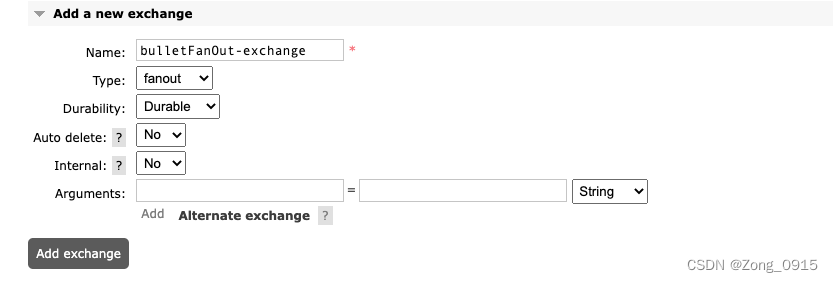
分别为两个
Socket
服务创建个队列,用来接收处理好的消息(练习下广播模式):
bulletSocket-queueAbulletSocket-queueB
再分别为他们和上述创建好的交换机进行绑定。
我们的弹幕服务主要做两件事:
- 监听预处理队列,数据来自:
originBullet-queue。 - 将处理完的消息通过广播,发送给
bulletSocket-queueA/B两个队列。
RabbitMQ
配置类如下:
importkz.common.SocketConstants;importorg.springframework.amqp.core.*;importorg.springframework.beans.factory.annotation.Qualifier;importorg.springframework.context.annotation.Bean;importorg.springframework.context.annotation.Configuration;/**
* @author Zong0915
* @date 2022/12/15 下午1:29
*/@ConfigurationpublicclassRabbitMQConfig{@BeanpublicQueueinitDirectQueue(){returnnewQueue(SocketConstants.ORIGIN_BULLET_QUEUE,true);}@BeanpublicQueueinitFanoutSocketQueueA(){returnnewQueue(SocketConstants.BULLET_SOCKET_QUEUE_A,true);}@BeanpublicQueueinitFanoutSocketQueueB(){returnnewQueue(SocketConstants.BULLET_SOCKET_QUEUE_B,true);}@BeanDirectExchangeinitDirectExchange(){returnnewDirectExchange(SocketConstants.BULLET_PRE_PROCESSOR_EXCHANGE,true,false);}@Bean("fanoutExchange")FanoutExchangeinitFanoutExchange(){returnnewFanoutExchange(SocketConstants.BULLET_FANOUT_EXCHANGE,true,false);}@BeanBindinginitBindingDirect(){returnBindingBuilder.bind(initDirectQueue()).to(initDirectExchange()).with(SocketConstants.BULLET_ORIGIN_MESSAGE_ROUTE_KEY);}@BeanBindinginitBindingFanoutA(@Qualifier("fanoutExchange")FanoutExchange fanoutExchange){returnBindingBuilder.bind(initFanoutSocketQueueA()).to(fanoutExchange);}@BeanBindinginitBindingFanoutB(@Qualifier("fanoutExchange")FanoutExchange fanoutExchange){returnBindingBuilder.bind(initFanoutSocketQueueB()).to(fanoutExchange);}}
2.2.2 生产者发送最终弹幕数据
创建
FanoutMessageProducer
类:记得向我们上面绑定的广播交换机发送数据。
importcom.alibaba.fastjson.JSONObject;importkz.entity.OriginMessage;importorg.springframework.amqp.rabbit.connection.CorrelationData;importorg.springframework.amqp.rabbit.core.RabbitTemplate;importorg.springframework.beans.factory.annotation.Autowired;importorg.springframework.stereotype.Component;importjava.util.HashMap;importjava.util.Map;importjava.util.UUID;/**
* @author Zong0915
* @date 2022/12/15 下午2:51
*/@ComponentpublicclassFanoutMessageProducer{@AutowiredprivateRabbitTemplate rabbitTemplate;publicvoidsend(OriginMessage originMessage){CorrelationData correlationData =newCorrelationData();
correlationData.setId(UUID.randomUUID().toString());// 唯一IDMap<String,Object> map =newHashMap<>();
map.put("message",JSONObject.toJSONString(originMessage));
rabbitTemplate.convertAndSend("bulletFanOut-exchange",// 交换机名称"",// 路由Key
map, correlationData);}}
2.2.3 消费者监听原始弹幕数据
创建
OriginMessageConsumer
类:
importcom.alibaba.fastjson.JSONObject;importcom.rabbitmq.client.Channel;importkz.service.BulletScreenService;importlombok.extern.slf4j.Slf4j;importorg.springframework.amqp.rabbit.annotation.*;importorg.springframework.beans.factory.annotation.Autowired;importorg.springframework.messaging.handler.annotation.Headers;importorg.springframework.messaging.handler.annotation.Payload;importorg.springframework.stereotype.Component;importjava.io.IOException;importjava.util.Map;/**
- @author Zong0915
- @date 2022/12/15 下午1:57
*/@Component@Slf4jpublicclassOriginMessageConsumer{@AutowiredprivateBulletScreenService bulletScreenService;/**
* 处理原始消息
*
* @param testMessage Map类型的消息体
* @param headers 消息头
* @param channel 消息所在的管道
*/@RabbitListener(
bindings =@QueueBinding(
value =@Queue(value ="originBullet-queue", durable ="true"),// 默认的交换机类型就是direct
exchange =@Exchange(name ="bulletPreProcessor-exchange", type ="direct"),
key ="bullet.originMessage"))@RabbitHandlerpublicvoidonOriginMessage(@PayloadMap testMessage,@HeadersMap<String,Object> headers,Channel channel)throwsIOException{
log.info("***********消费开始*************");
log.info("消费体:{}",JSONObject.toJSONString(testMessage));
bulletScreenService.processMessage(testMessage, headers, channel);}}
2.创建
BulletScreenService
类用于原始弹幕的业务处理,主要考虑的几个点:
- 消息的合法性校验。
- 消息的幂等性保证,这里用了
Redis做个存储。 - 将原始数据处理完后,在丢给
MQ进行广播。
importcom.alibaba.fastjson.JSONObject;importcom.rabbitmq.client.Channel;importkz.common.SocketConstants;importkz.entity.OriginMessage;importkz.producer.FanoutMessageProducer;importlombok.extern.slf4j.Slf4j;importorg.apache.commons.lang3.StringUtils;importorg.springframework.amqp.support.AmqpHeaders;importorg.springframework.beans.factory.annotation.Autowired;importorg.springframework.data.redis.core.StringRedisTemplate;importorg.springframework.scheduling.annotation.Async;importorg.springframework.stereotype.Service;importjava.io.IOException;importjava.util.Map;importjava.util.Optional;importjava.util.UUID;importjava.util.concurrent.TimeUnit;/**
* @author Zong0915
* @date 2022/12/9 下午3:45
*/@Service@Slf4jpublicclassBulletScreenService{@AutowiredprivateStringRedisTemplate redisTemplate;@AutowiredprivateFanoutMessageProducer fanoutMessageProducer;@AsyncpublicvoidprocessMessage(Map testMessage,Map<String,Object> headers,Channel channel)throwsIOException{OriginMessage originMessage =getOriginMessage(testMessage);// 合法性校验if(!validMessage(testMessage, headers, originMessage)){return;}// 处理消息
log.info("***********业务处理,弹幕: {}***********", originMessage.getMessage());String correlationId = headers.get(SocketConstants.ID).toString();// 存入Redis并设置过期时间1天
redisTemplate.opsForSet().add(SocketConstants.CORRELATION_SET_PRE+ originMessage.getRoomId(), correlationId);
redisTemplate.expire(SocketConstants.CORRELATION_SET_PRE+ originMessage.getRoomId(),1,TimeUnit.DAYS);// 将处理好的消息发送给MQ,通过广播队列,将消息发送给所有的Socket服务,一般这里还会对originMessage进行一些二次封装// 本案例就不做处理了,原样返回
fanoutMessageProducer.send(originMessage);// 确认消息Long deliveryTag =(Long) headers.get(AmqpHeaders.DELIVERY_TAG);
channel.basicAck(deliveryTag,false);}publicOriginMessagegetOriginMessage(Map testMessage){String messageJson =(String) testMessage.get(SocketConstants.MESSAGE);if(StringUtils.isBlank(messageJson)){returnnull;}OriginMessage originMessage =JSONObject.parseObject(messageJson,OriginMessage.class);return originMessage;}/**
* 对消息进行合法性校验
*/publicbooleanvalidMessage(Map testMessage,Map<String,Object> headers,OriginMessage originMessage){// 判空if(testMessage ==null|| testMessage.size()==0|| originMessage ==null){returnfalse;}if(headers ==null|| headers.size()==0){returnfalse;}// 幂等性校验,如果消息已经被消费过了,那么这个弹幕消息就不应该被二次消费,这个消息就直接把他处理掉UUID correlationId =(UUID) headers.get(SocketConstants.ID);Boolean exist = redisTemplate.opsForSet().isMember(SocketConstants.CORRELATION_SET_PRE+ originMessage.getRoomId(), correlationId.toString());return!Optional.ofNullable(exist).orElse(false);}}
最后就是启动类
BulletScreenApplication
:
importorg.springframework.boot.SpringApplication;importorg.springframework.boot.autoconfigure.SpringBootApplication;importorg.springframework.cloud.client.discovery.EnableDiscoveryClient;importorg.springframework.scheduling.annotation.EnableAsync;/**
* @author Zong0915
* @date 2022/12/10 下午9:44
*/@SpringBootApplication@EnableDiscoveryClient@EnableAsyncpublicclassBulletScreenApplication{publicstaticvoidmain(String[] args){SpringApplication.run(BulletScreenApplication.class, args);}}
2.3 Socket服务监听弹幕数据并返回前端
记得在
pom
依赖中引入上面的公共包:
<dependency><groupId>bullet-service</groupId><artifactId>service-bulletcommon</artifactId><version>1.0-SNAPSHOT</version></dependency>
2.3.1 配置类
RabbitMQ
配置类增加下队列和交换机的配置信息:绑定
bulletSocket-queueA
@BeanpublicQueueinitFanoutSocketQueueA(){returnnewQueue(SocketConstants.BULLET_SOCKET_QUEUE_A,true);}@Bean("fanoutExchange")FanoutExchangeinitFanoutExchange(){returnnewFanoutExchange(SocketConstants.BULLET_FANOUT_EXCHANGE,true,false);}@BeanBindinginitBindingFanoutA(@Qualifier("fanoutExchange")FanoutExchange fanoutExchange){returnBindingBuilder.bind(initFanoutSocketQueueA()).to(fanoutExchange);}
另一个
Socket
项目,添加以下配置:绑定
bulletSocket-queueB
@BeanpublicQueueinitFanoutSocketQueueB(){returnnewQueue(SocketConstants.BULLET_SOCKET_QUEUE_B,true);}@Bean("fanoutExchange")FanoutExchangeinitFanoutExchange(){returnnewFanoutExchange(SocketConstants.BULLET_FANOUT_EXCHANGE,true,false);}@BeanBindinginitBindingFanoutA(@Qualifier("fanoutExchange")FanoutExchange fanoutExchange){returnBindingBuilder.bind(initFanoutSocketQueueB()).to(fanoutExchange);}
再写一个缓存工具类,通过直播间号获得同一个直播间下的所有WebSocket信息:
publicclassSocketCache{publicstaticList<BulletScreenServer>getSocketGroupByRoomId(String roomId){ArrayList<BulletScreenServer> res =newArrayList<>();if(StringUtils.isBlank(roomId)){return res;}for(Map.Entry<Integer,ConcurrentHashMap<String,BulletScreenServer>> hashMapEntry :CACHE_SEGMENT.entrySet()){ConcurrentHashMap<String,BulletScreenServer> map = hashMapEntry.getValue();if(map ==null|| map.size()==0){continue;}for(BulletScreenServer server : map.values()){if(server.getSession().isOpen()&&StringUtils.equals(roomId, server.getRoomId())){
res.add(server);}}}return res;}}
2.3.2 消费者
重点就是消费者的业务代码了,对最终的弹幕数据进行广播,创建
FanOutMessageConsumer
类:
importcom.alibaba.fastjson.JSONObject;importcom.rabbitmq.client.Channel;importkz.cache.SocketCache;importkz.common.SocketConstants;importkz.entity.OriginMessage;importkz.service.BulletScreenServer;importlombok.extern.slf4j.Slf4j;importorg.apache.commons.lang3.StringUtils;importorg.springframework.amqp.rabbit.annotation.*;importorg.springframework.amqp.support.AmqpHeaders;importorg.springframework.messaging.handler.annotation.Headers;importorg.springframework.messaging.handler.annotation.Payload;importorg.springframework.stereotype.Component;importjava.io.IOException;importjava.util.List;importjava.util.Map;/**
* @author Zong0915
* @date 2022/12/15 下午1:57
*/@Component@Slf4jpublicclassFanOutMessageConsumer{/**
* 处理弹幕消息,开始广播
*
* @param testMessage Map类型的消息体
* @param headers 消息头
* @param channel 消息所在的管道
*/@RabbitListener(
bindings =@QueueBinding(
value =@Queue(value ="bulletSocket-queueA", durable ="true"),// 默认的交换机类型就是direct
exchange =@Exchange(name ="bulletFanOut-exchange", type ="fanout")))@RabbitHandlerpublicvoidonOriginMessage(@PayloadMap testMessage,@HeadersMap<String,Object> headers,Channel channel)throwsIOException{
log.info("***********消费开始, Socket服务A接收到广播消息*************");
log.info("消费体:{}",JSONObject.toJSONString(testMessage));OriginMessage originMessage =getOriginMessage(testMessage);if(originMessage ==null){return;}// 根据roomID去找到同一个直播间下的所有用户并广播消息List<BulletScreenServer> socketGroupByRoomId =SocketCache.getSocketGroupByRoomId(originMessage.getRoomId());for(BulletScreenServer bulletScreenServer : socketGroupByRoomId){
bulletScreenServer.getSession().getBasicRemote().sendText(JSONObject.toJSONString(originMessage));}// 确认消息Long deliveryTag =(Long) headers.get(AmqpHeaders.DELIVERY_TAG);
channel.basicAck(deliveryTag,false);}publicOriginMessagegetOriginMessage(Map testMessage){String messageJson =(String) testMessage.get(SocketConstants.MESSAGE);if(StringUtils.isBlank(messageJson)){returnnull;}OriginMessage originMessage =JSONObject.parseObject(messageJson,OriginMessage.class);return originMessage;}}
另一个
Socket
服务则改一下消费者的监听队列和日志内容即可:
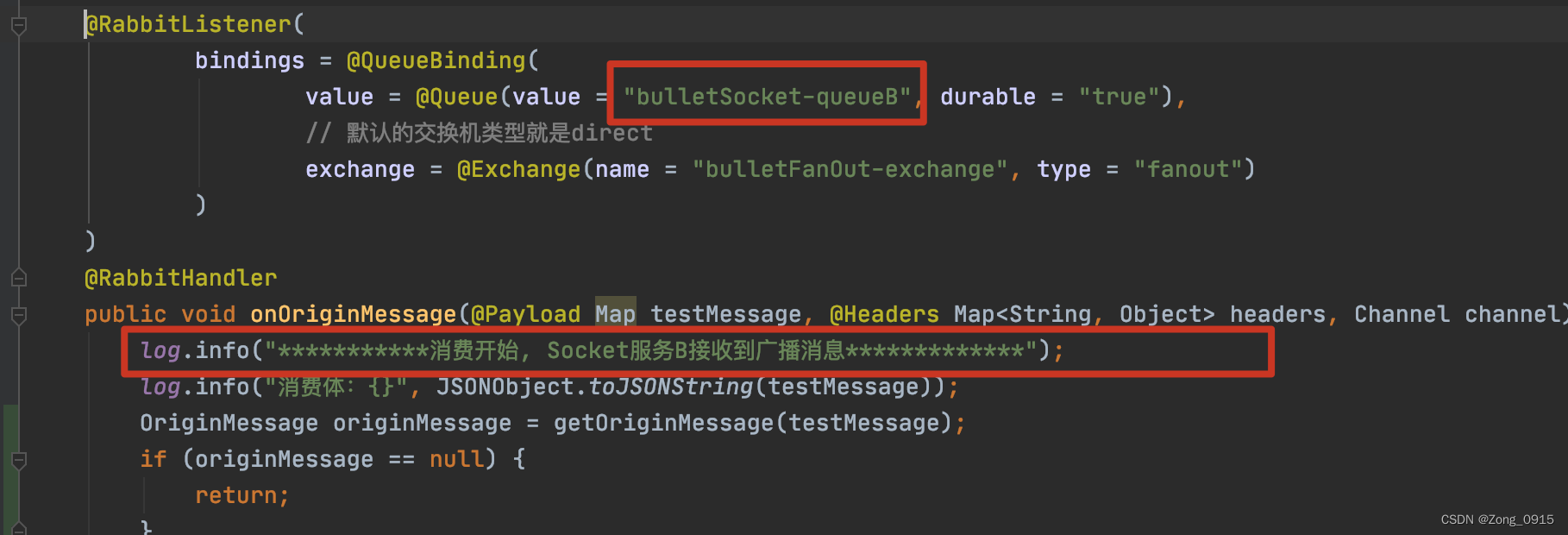
2.4 测试
打开同一个直播间的两个用户,让两个WebSocket正好建立到不同的服务器上:
此时
Socket
服务A:
Socket
服务B:
页面A中随便发送一条弹幕: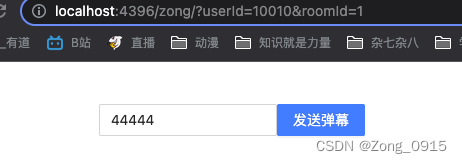
页面B中随便发送一条弹幕: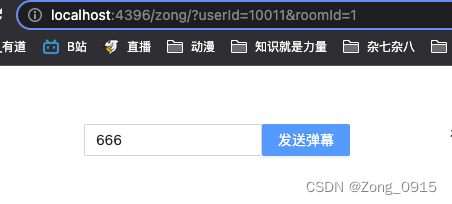
1.前端发送一条弹幕,后端监听到,开始向预处理队列丢消息。
2.
service-bulletscreen
服务,监听到预处理队列数据,开始进行处理。

3.经过一系列校验和幂等性处理之后,将处理完的弹幕通过交换机发送给广播队列:
4.
Socket
服务B接收到消息:
Socket
服务
A
接收到广播消息:
5.前端页面展示:
页面A:
页面B:
到这里,一个聊天服务就完成了。不过大家也看到在线人数这块咱没做。可以用
Redis
缓存来记录每个直播间的人数。这个功能放到下一篇文章来讲。
版权归原作者 Zong_0915 所有, 如有侵权,请联系我们删除。